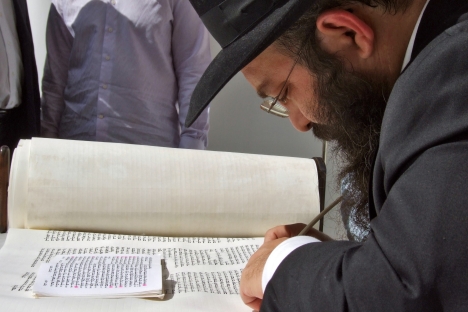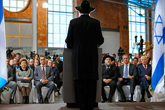Moscow’s vanished Jewish ghetto

Source: Kommersant
Today, the area just below Kitai Gorod's Ulitsa Varvarka is a fenced-off construction zone. Following the demolition of Hotel Rossiya, it has stood empty, a series of projects to revamp it stalled.
But a century and a half ago, this barren land just east of the Kremlin held the cobblestone streets of Glebovskoye Podvorye, the only place where Jews could live in Moscow. Founded in 1826, it evolved from a strictly policed ghetto to a vibrant urban crossroads, where rich businessmen paid visits to basement fortune tellers and women baked matzo in the open air.
Beginning in 1791, Russia's Jews were restricted to the Pale of Settlement, an Eastern European territory created by Catherine the Great. Only registered traders had the right to travel to Moscow. The handful that made the journey usually stayed on the backstreets of Zaryadye, a neighbourhood near the Trading Rows, the historic marketplace by the Kremlin.
But after local merchants complained about competition from Jews, an imperial command was issued in 1826 restricting Jewish traders to the area in Zaryadye, for stays of one to three months only.
The following year, an edict allowing Jews to serve in the military brought an influx of Jewish soldiers and their families to Moscow. The number of visitors to Glebovskoye Podvorye, as it had become known, grew to several hundred per year.
Upon entering the city, Jewish visitors were escorted to Zaryadye by a police convoy. The entrance gate was locked from dawn to dusk, and life inside was subject to constant surveillance.
But beyond monitoring Jewish activity, there was another reason for the city to maintain Glebovskoye Podvorye: it was a lucrative business opportunity.
“[Jews] were forced to purchase only the goods and services provided by the local administration, for whatever price was dictated to them. They had no options,” said Ilya Barkussky, a historian and guide at the Museum of Jewish History in Russia.
In 1847, a prominent Jewish merchant lodged a complaint with the Ministry of Internal Affairs. An inspector who arrived from St. Petersburg was horrified by what he saw:
“The humiliations that they endure exceed all belief,” he wrote in an official report. “Obligated to live there against their will, driven there like animals to a farmyard, they bow down not only to the inspector, whom they call their master, but even to the cleaners.”
Even though Moscow's governor general was informed of the savage report, he insisted that Glebovskoye Podvorye be kept open: Moscow's first eye hospital, located at Nikitskiye Vorota, was dependent on Jewish patients for its income.
Life in the “Moscow ghetto” (as locals called it) changed in 1856, when reformist Tsar Alexander II decreed that Jews could settle freely. Moscow's Jewish population boomed, leading to new communities in Kitai Gorod and Lefortovo. By 1889, Moscow was home to 26,000 Jews, or three percent of the city's population.
“Glebovskoye Podvorye lost its significance as the sole place where Jews could settle, but it remained a key centre of Jewish life,” Barkussky said.
With half the population still Jewish, the area turned into a popular bazaar. Poet Ilya Belousov described life there in the 1870s in his memoir “Ushedshaya Moskva” (Vanished Moscow):
“Jewish traders with victuals and various small goods set up shop not only on the sidewalk, but right on the bridge,” he wrote. “The side streets were full of Jewish butchers, sausage shops and bakeries, which produced an incredible amount of matzo before Passover.”
Glebovskoye Podvorye's dank basements were home to fortune tellers, who were consulted by the city's leading businessmen (as police turned a blind eye). Less-established mystics solicited passersby near the gates.
Seeking to cut costs, building owners built suspended outdoor walkways (‘galdareiki’) that provided access to the apartments in place of stairwells. In summer, they became hubs of work and social life.
The neighbourhood was razed in the 1960s to make way for the Hotel Rossiya.
“Cobblers sat on benches and banged with hammers, Jewish furriers worked with Polish and Kamchatka beaver pelts or sewed rags, housewives came out with their sewing, kids swarmed around,” Belousov wrote. “On holidays, choirs gathered on the walkways and sang songs.”
The walkways of a building on Pskovsky Pereulok later appeared in Sergei Eisenstein's first full-length feature, Strike (1925). In the film's penultimate scene, tsarist police on horseback pursue frantic workers across the footpaths, lashing them as they go; one drops a toddler from a height of several stories.
Jewish custom was strictly observed in the ghetto: Belousov describes how a hush always fell over the neighbourhood on Friday at sundown. In preparation for Passover, women processed to the Moscow River to wash dishes.
Glebovskoye Podvorye's heyday came to an end in 1891, when Nicholas II forcibly resettled Jews to the hinterland. (Jews were allowed to return to Moscow with the outbreak of World War I, but the community moved to Marina Roshcha).
After 1917, the settlement was turned into communal apartments.
“The buildings weren't touched for the next 30 years,” said Moscow historian Alexei Dedushkin. “Everything just fell apart.”
In the 1930s, Stalin set his sights on the slums for the location of the People's Commissariat for Heavy Industry, a behemoth that echoed the planned Palace of Soviets in design. Though the project was never completed, the land was razed for the construction of the never-realised eighth of Stalin's Seven Sisters skyscrapers. After this too fell through, Khrushchev placed the mammoth Hotel Rossiya on the spot, wiping out the final remnants of historic Zaryadye. Today, no hint of Glebovskoye Podvorye remains on the excavated land.
In the late '30s, a group of photographers was dispatched to document the area. The shots they took became the last testament of the community that once was.
In a photo taken in the courtyard, clotheslines hang by a crumbling kindergarten. Nearby, a cluster of residents in newsboy caps stare curiously at the camera. Due to multiple exposure, a figure appears to flit before the lens, then vanish.
The Jewish metropolis had become a ghetto once more.
Jewish history in Moscow
Learn more about Glebovskoye Podvorye and the history of Jews in Moscow at the Museum of Jewish History in Russia. Located near Dynamo metro station, the private museum was opened two years ago by Sergei Ustinov, a Moscow journalist-turned-businessman. Its collection is focused on the political and social history of Eastern Europe's Ashkenazi Jews, with an additional display on Georgian, Bukhari and Mountain Jews. Visitors see a wide range of artefacts of daily life, including the passports that 19th-century traders had to carry when travelling to Moscow, playbills from Jewish theatres and kosher vodka from the 1920s.
First published in The Moscow News.
All rights reserved by Rossiyskaya Gazeta.
Subscribe
to our newsletter!
Get the week's best stories straight to your inbox
